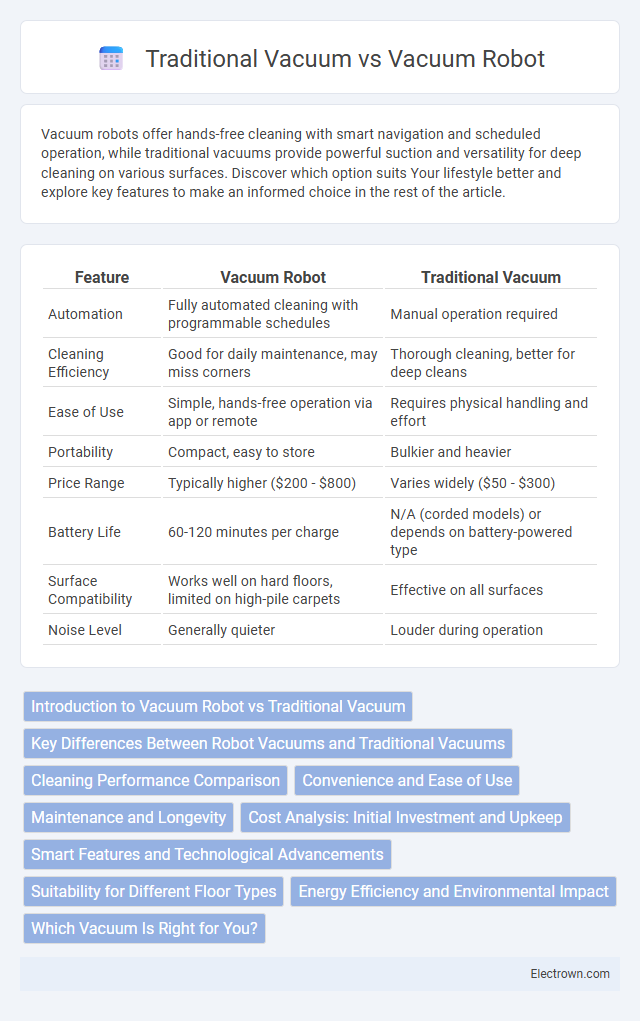Vacuum robots offer hands-free cleaning with smart navigation and scheduled operation, while traditional vacuums provide powerful suction and versatility for deep cleaning on various surfaces. Discover which option suits Your lifestyle better and explore key features to make an informed choice in the rest of the article.
Table of Comparison
| Feature | Vacuum Robot | Traditional Vacuum |
|---|---|---|
| Automation | Fully automated cleaning with programmable schedules | Manual operation required |
| Cleaning Efficiency | Good for daily maintenance, may miss corners | Thorough cleaning, better for deep cleans |
| Ease of Use | Simple, hands-free operation via app or remote | Requires physical handling and effort |
| Portability | Compact, easy to store | Bulkier and heavier |
| Price Range | Typically higher ($200 - $800) | Varies widely ($50 - $300) |
| Battery Life | 60-120 minutes per charge | N/A (corded models) or depends on battery-powered type |
| Surface Compatibility | Works well on hard floors, limited on high-pile carpets | Effective on all surfaces |
| Noise Level | Generally quieter | Louder during operation |
Introduction to Vacuum Robot vs Traditional Vacuum
Vacuum robots offer automated cleaning with smart navigation, allowing you to maintain floors effortlessly while traditional vacuums require manual operation and physical effort. These intelligent devices use sensors to avoid obstacles and cover large areas systematically, enhancing convenience and time efficiency. Traditional vacuums often provide powerful suction and versatile attachments but lack the autonomous capabilities found in vacuum robots.
Key Differences Between Robot Vacuums and Traditional Vacuums
Robot vacuums operate autonomously with programmable schedules and smart sensors, enabling efficient cleaning without manual intervention. Traditional vacuums require direct handling and often offer stronger suction power, suitable for deep carpet cleaning and heavy-duty tasks. Your choice depends on convenience versus power, with robot vacuums excelling in daily maintenance and traditional models providing thorough, hands-on cleaning.
Cleaning Performance Comparison
Vacuum robots utilize advanced sensors and mapping technology to navigate and clean floors efficiently, delivering consistent performance on hard surfaces and low-pile carpets. Traditional vacuums typically offer stronger suction power, making them more effective on deep-pile carpets and for removing embedded dirt and pet hair. While robotic vacuums excel in automated daily maintenance, traditional vacuums provide more thorough and customizable cleaning for heavy-duty tasks.
Convenience and Ease of Use
Vacuum robots offer unparalleled convenience by providing hands-free cleaning that can be scheduled and controlled via smartphone apps, reducing the need for manual labor. Traditional vacuums require physical effort for operation and maneuvering, often demanding more time and energy, especially in larger spaces. The compact design and autonomous navigation of vacuum robots enable efficient cleaning in hard-to-reach areas, enhancing overall ease of use compared to conventional models.
Maintenance and Longevity
Vacuum robots require less frequent maintenance due to self-cleaning features and easy-to-empty dustbins, extending their usability with minimal effort. Traditional vacuums demand regular filter changes, bag replacements, and brush cleaning, which can shorten their lifespan if neglected. Your choice impacts long-term convenience and durability, with vacuum robots offering streamlined upkeep compared to the intensive care traditional models need.
Cost Analysis: Initial Investment and Upkeep
Vacuum robots typically have a higher initial investment, ranging from $200 to $1,000 depending on brand and features, compared to traditional vacuums, which can cost between $50 and $400. Upkeep expenses for robots include replacement brushes and batteries every 1-2 years, potentially adding $50-$150 annually, while traditional vacuums mostly incur costs for bags, belts, and filters, averaging $20-$60 per year. The automation and time-saving benefits of vacuum robots may justify the higher cost for tech-savvy users, whereas budget-conscious consumers often prefer the lower upfront and maintenance expenses of traditional models.
Smart Features and Technological Advancements
Vacuum robots incorporate advanced smart features like AI-powered navigation, obstacle detection, and automated scheduling, enhancing cleaning efficiency compared to traditional vacuums. These robots utilize sensors and mapping technology to adapt to different floor types and avoid furniture, reducing manual intervention. Your cleaning routine benefits from these technological advancements by saving time and ensuring consistent cleanliness with minimal effort.
Suitability for Different Floor Types
Vacuum robots excel on hard floors and low-pile carpets due to their advanced sensors and automatic adjustments, making them suitable for daily maintenance of smooth surfaces. Traditional vacuums outperform on thick carpets and rugs, offering stronger suction power and customizable settings to deep-clean various textures. You can choose based on your flooring; robots for convenience on tile or hardwood, and traditional vacuums for thorough cleaning of high-pile carpets or uneven surfaces.
Energy Efficiency and Environmental Impact
Vacuum robots use advanced sensors and programming to optimize cleaning paths, resulting in lower energy consumption compared to traditional vacuums with less efficient motors and random cleaning patterns. Many vacuum robots are designed with rechargeable lithium-ion batteries, reducing reliance on disposable batteries and lowering overall environmental impact. Traditional vacuums often rely on higher wattage power sources, leading to increased electricity usage and greater carbon emissions over time.
Which Vacuum Is Right for You?
Vacuum robots offer hands-free cleaning with programmable schedules and smart navigation, ideal for busy households and tech-savvy users seeking convenience. Traditional vacuums provide powerful suction and versatility for deep cleaning carpets, stairs, and upholstery, making them suitable for homes with heavy dirt or pet hair. Choosing the right vacuum depends on your lifestyle, floor types, and cleaning preferences, balancing automation with performance needs.
Vacuum Robot vs Traditional Vacuum Infographic

 electrown.com
electrown.com